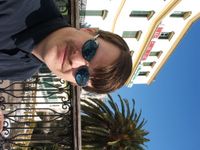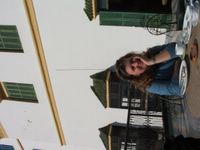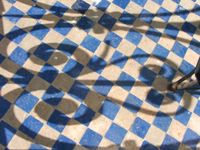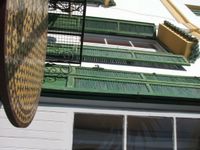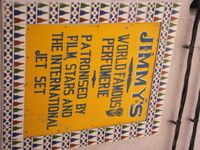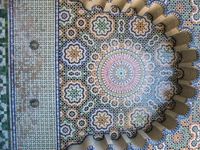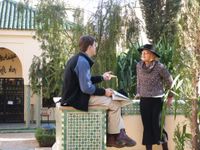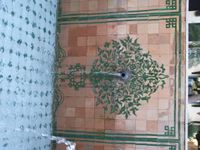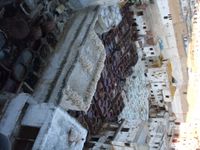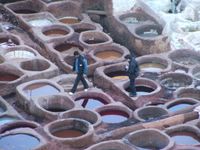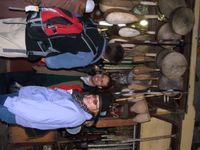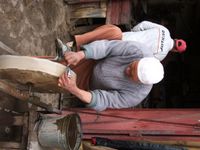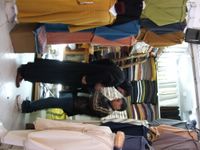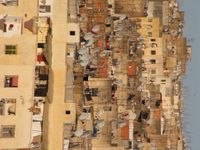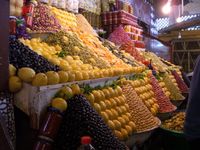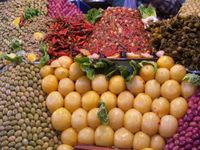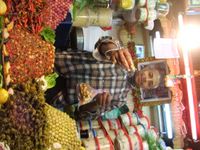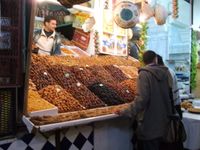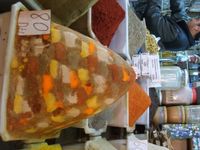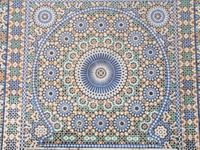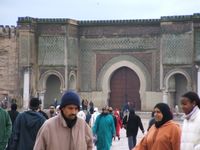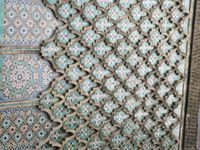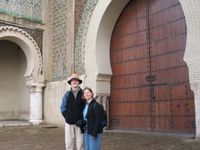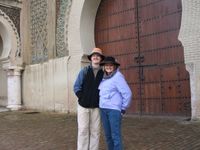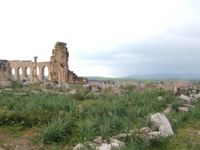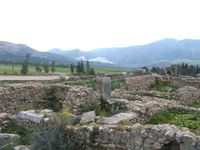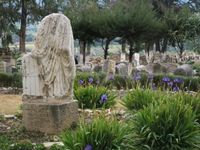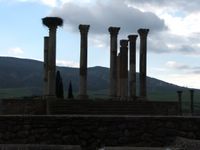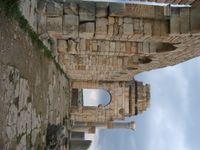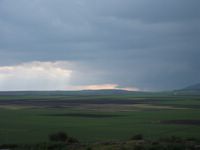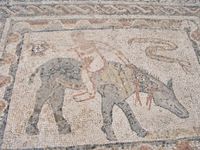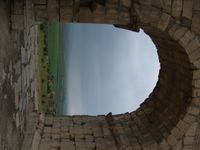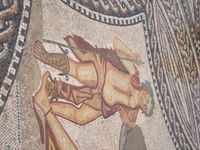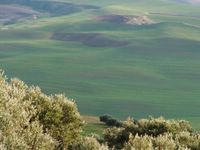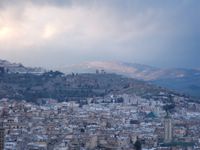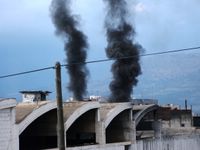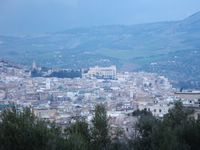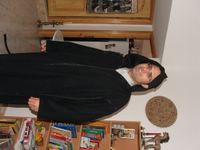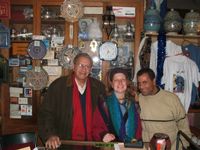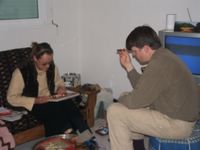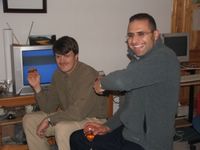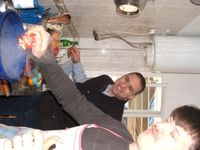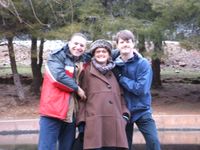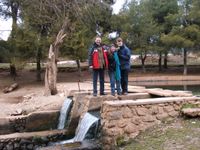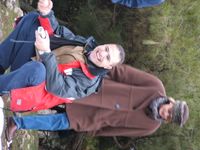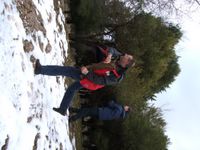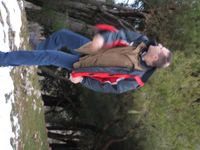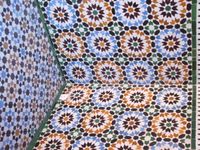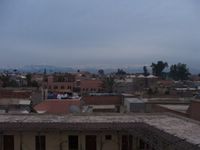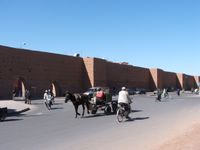Fool's Guide to Morocco
From Barcelona by overnight train and connection to Algeciras, where there seemed little to do of a morning except catch a ferry to Morocco. This chapter of our blog details the adventures in Morocco of Becky and Tom. Tom returns to the keyboard, while Becky has posted photographs mostly taken by her (although with some entertaining exceptions). Becky has also posted some extra pictures from Barcelona beneath the Moroccan photographs, for those who want to get a bit more Gaudi in their web-browsing.
For the technically interested - don't get me wrong, some of my best friends are technically interested - this chapter has been drafted in Microsoft Word, allowing frequent saves to the local hard disk, before mounting. Your humble author shall no longer plead data loss as an excuse for tardy posting.
So, we're in Algeciras on the 2nd of February. The temperature is 23 degrees, rather warmer than most of Europe. We shake off the many crooks and liars who try to sell us their own tickets on the cross-Straits ferry, paying more or less the same amount to the bored and underworked bureaucrats in the ticket office at the ferry
terminal. And we go and catch a boat to Tanger.
Three things really struck us about the ferry. One was Africa - only a few miles across the water, and just kind of sitting there. Another was Gibraltar. Algeciras, being the Spanish ¡I can't believe it's not Gibraltar! is so underwhelmingly and unglamorously bland, compared with the stupendously imposing, almost mystical, blandness of that royal rock. Ah, blue blood doth yatter yatter. Third was that the Straits were absolutely full of dolphins. They were all around us throughout the 75 minute ride.
In Tanger, as advised by Christine Vizzard, an old family friend, we headed straight to the Hotel Continental. Here they shot several of the scenes for 'The Sheltering Sky.' It is one of the most tedious films ever made, right down there with Peter Greenaway at his worst, but the hotel is a stunning piece of faded colonial glory. Very
expensive by Moroccan standards, but quite cheap by Australian.
Tanger is a most romantic location, at the meeting point of Mediterranean Sea and Atlantic Ocean. The old town ('the medina') is a Knowledge Nation diagram of crazy stairs called streets. And the hustlers there are very very adept at getting money off anyone who looks touristic. This actually applies through lots of Morocco, and gets very tiring if you go out a lot. But the alternative is not to see the country you have come so far to be in, which is just stchoupid, so one has to find a balance.
The following evening we caught a CTM bus to Fes. This is the government-run company, so it costs a bit more than the privates, but its buses are much more likely to get there -- the competition's hapless drivers are forever getting pinged by the police for having insufficient documents to hand. Having driven in Croatia and in Spain recently, I reckon Moroccan driving is very bad. (And yet we saw no serious accidents in the two weeks we were there.) It seems to be complete anarchy. Becky and I tried to count up the different meanings of a
car horn, which were so diverse and even bizarre that we eventually lost track of them... Eg:
1. Move over, please.
2. Move over, not please.
3. I am overtaking you and shall pull back in very shortly -- it's your lookout to make sure I don't crash into you.
4. Now is not the time and place to be getting legalistic -- I am in a very large vehicle.
5. You are a dead set bloody goose.
6. You are a dead set bloody legend.
7. Oh look - an eagle!
8. Make way for royalty!
Fes is a very Arabic town, meaning it is noticeably more conservative than the more cosmopolitan Berber towns we visited elsewhere. You see few women on the streets, and almost none in the cafes and tea houses. Weather in Fes was rather on the coolish side. It is a similar latitude and altitude to Canberra: probably hotter in summer and definitely colder in winter. We stayed with Christine and her husband Abdulkader, who are two of the world's more splendid hosts. It was as though they dropped everything for 5 days to show us around their city and the surrounding countryside.
Abdulkader is a tremendous cook - the King of the Tajine - and he seemed to have friends everywhere we went. Christine is one of the four Australians living in Fes - she knows them well - and seems to know the ethnic history of every town - no small feat in a land with such a history of migration and diversity. We were introduced to several stalwarts of the local Jewish community, who congregate at the bizarre-cum-salon of a certain Jacques, a friend of Christine. She and Abdulkader are now looking to set up a bed and breakfast on the
coast, probably in Essouera - so if anybody is looking to travel to Morocco in 2006 or beyond, we would be very happy to put you in touch.
Highlights of the Fes visit included a visit to the ruins of Volubilis, the southernmost city in the Roman Empire. This is really wild, overgrown and settled by contented storks. You walk through an old corridor and trip over the remains of an oil-press. Or you stumble on one of the lesser mosaics in some former courtyard. From the entrance, you see the holy city of Moulay Idriss, buildings all in white, like a pair of wavecrests surging through the hills. We were told that three visits to Moulay Idriss are regarded a reasonable substitute for Muslims who cannot make it to Mecca. Non-Muslims are allowed to visit by day, but only the faithful are permitted within
the town overnight. Another highlight for me was getting my hair cut by a real Berber barber in Barbary: it's a lifetime of small talk out of one $3 short back and sides, so be warned. (I should add that it was really expertly done.)
From Fes we caught a train to Marrakech on 9 February. The train was definitely less stressful than anything involving roads, although it seems to be the posh way to travel through Morocco: our compartment-companions were all a bit on the bourgie side. Where Fes was a terrific place to know locals, Marrakech is a terrific place to
go and just be an unattached tourist. The hotels are cheap, the food is superb, the mint tea is abundant and sweet. And in winter the orange juice on every corner and in every square and souk was out of this world.
Becky and I stayed in the CTM Hotel, fronting the Jemaa al Fna - the main square of Marrakech, a place of many mysteries and a name of many spellings. By sunset we would sit on our balcony, reading or playing backgammon, watching the motorbikes and the bustling markets, the snakecharmers, the fancy-dress hustlers, the foodstalls. Then, as the sun dipped, their amazing racket would be interrupted by the wailing call to prayer. Our hotel cafe would turn the stereo down for a few minutes, even the motorbikes seemed to motor more quietly and honk less, and we would hear the muezlins chanting into their megaphones. Most were mostly megaphone drone, but a couple were really wailing beautifully. God is great. Come and pray. The sun is setting. Come
and pray.
Moroccan architecture is like a lot of Mediterranean architecture, in that what is really beautiful is to be found more within homes than outside them. Unfortunately for us, Moroccan law forbids non-Muslims to enter mosques, meaning we were unable to see much of what is most beautiful. Still, the museums and galleries of Marrakech, along with several extremely posh hotels converted from old Riads, gave us many
spectacular views of the peace and beauty within the walls. Becky's photography captures much of this below, and you will see more shortly when she posts our photographs from Andalucia, where we have made
these latest postings.
After four nights in Marrakech, we caught the overnight train back to Tanger (this is a little bit hard going without a couchette), then a morning ferry across the Straits to Algeciras. By the end of this visit, we had become quite hard to hustle, and Becky had settled into a method of hard, fair shopping. Think: a good hip-and-shoulder. A
wonder to behold her, at least one grandparent I can think of would be very proud.
Posted by Tom in Jerez.
